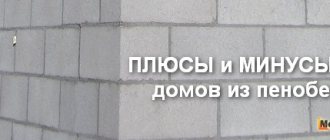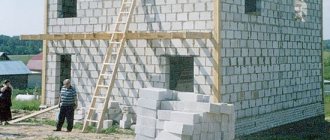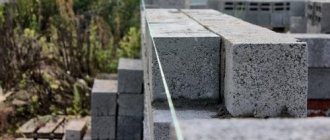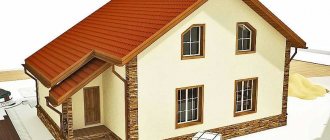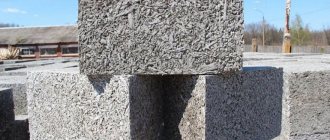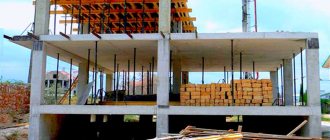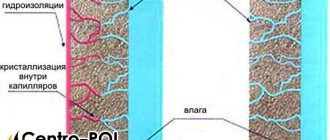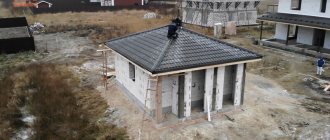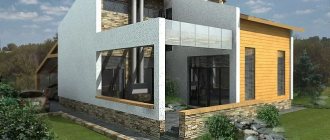The old cinder blocks have been replaced by a material that has replaced them with dignity. It is in great demand in construction and is famous for its remarkable technical characteristics and positive aspects. Houses, garages, bathhouses, agricultural buildings and other buildings are built from it. The products are quite easy to work with, and for processing you do not need to have high-tech tools. Due to its porous structure, the material is lightweight, has a low thermal conductivity coefficient and perfectly protects the room from noise. Even bad weather is not scary for him, since he is not afraid of moisture. And thanks to its environmental friendliness, it is used everywhere. What kind of miracle material is this? We are talking about expanded clay blocks.
Expanded clay is known to everyone as an insulating material. But by adding large and small fractions of expanded clay to concrete, a universal material was obtained, ideal for building houses. A house made of expanded clay block is a fairly popular design. You might think that with such characteristics, its cost would be exorbitant. But don't rush to conclusions. Expanded clay concrete is very affordable. Its price is even lower than gas silicate blocks. In this article we will discuss the pros and cons of houses made of expanded clay concrete blocks, and also find out reviews from owners who have already built similar buildings.
Features of expanded clay concrete blocks for home
Expanded clay concrete blocks are made using standard technology. The composition is quite simple and understandable. Here is the usual set for concrete: sand, cement and water. However, it is the filler that makes expanded clay concrete blocks what they are. The main component of this material for building a house is expanded clay. One product combines the positive aspects of concrete and expanded clay. That's why it has so many benefits.
Note! The construction of houses made of expanded clay concrete blocks in Russia began actively 60 years ago. Just as the products were popular then, they are still popular today.
Due to its dimensions and weight, building a house is much faster. The standard block has dimensions: 188 mm – width, 390 mm – length, 190 mm – height. And its weight can reach 15 kg. The technology for laying the walls of a block house is very simple. And due to the different shapes and purposes of the blocks, the design can be improved. Blocks can be hollow or solid. It will be convenient for you to transport, store and serve them at height. The masonry of a block house is identical to that of brick. But, in the first case, it takes less solution, effort and time.
Now everyone wants to insulate the house from the inside or outside in order to retain the generated heat and save on heating costs. However, a clear advantage of the expanded clay concrete block is its level of thermal conductivity. A house made of this material will be warm. And since expanded clay concrete is also a sound insulator, extraneous noise from the street will not disturb you.
Here is a list of the main characteristics of expanded clay concrete:
- Moisture resistant.
- Light weight material.
- High strength and reliability.
- Resistance to rotting and the influence of microorganisms.
- Expanded clay concrete is not afraid of temperature changes.
- Is fireproof.
- Does not rust.
- Excellent vapor permeability of the walls of the house.
On store shelves you can find various brands of expanded clay concrete. What do they mean? Blocks have special letters indicating the category. For example:
- P – septal;
- P - means that it is ordinary (unpresentable, requires subsequent finishing of the walls of the house);
- L – front (presentable, not requiring finishing);
- C – wall.
The following letters indicate the purpose in the design. For example, PZ is used for bandaging seams, UG is used at corners, PR is an order product. If the block is hollow, then PS is indicated. The marking also includes length, compressive strength, frost resistance and density. If you see the marking of the expanded clay concrete block KSL-PR-PS-390-75-F20-1200, then you will understand that this is a facing stone for walls, decent with voids, length 390 mm, strength 75, freezing cycles 20 and density 1200. A Why are houses made from expanded clay concrete blocks so good?
Arguments for"
Low cost
To make this obvious, we present the comparative cost of 1 m3 of masonry (in rubles) of some materials:
- expanded clay concrete – 2,250;
- foam concrete – 2,650;
- brick – from 5,500.
Although these are indicative prices, they give a general idea.
The versatility of masonry
It is understood that you can use either a traditional cement-based mortar or a (special) adhesive composition. While, for example, gas silicate blocks are held together only with special glue.
Simple technology
Firstly, this is explained by the identical (if the products are not “handicraft” made) dimensions of the blocks.
Secondly, the relatively small mass of the products makes it possible to do without lifting mechanisms. For example, a “standard” solid wall block weighs about 25 kg (390 x 190 x 188). Slotted, septal - and even less. Read more about the production process and the necessary equipment for expanded clay concrete blocks.
At the same time, there is some difficulty in processing expanded clay concrete. To cut it, you will need a saw with pobedite teeth.
The structure of the blocks allows the walls to “breathe”
This is due to the sufficient vapor permeability of the material. Consequently, the microclimate in the house will be maintained at a constant level with a minimum of additional costs.
Good performance
Yes, expanded clay blocks are characterized by frost and moisture resistance; they “keep” heat in the house. There are also a number of other attractive options. But if you look at reviews of other building materials, they say almost the same thing. Probably, it’s all about the correct selection of products in relation to the climate (critical temperatures, humidity, and so on).
House made of expanded clay concrete blocks: pros and cons
Building a house is every man’s dream. However, this is not an easy task. Not only do you need to choose a material, you also have to work hard to create a comfortable, durable and warm structure. Many owners of houses created from expanded clay blocks are very glad that they chose this material. Why are houses so good?
Advantages:
- Since the material is light, the house will not have a huge mass. You do not need to spend money, time and effort on building a massive and deep foundation; the blocks are quite easy to transport; you will be able to work on the house without special equipment.
- Low thermal conductivity coefficient. Thanks to this, your home will be warm. You just need to install high-quality windows and doors.
- Since the product is vapor permeable, the walls of the house will “breathe”. And so what? No condensation, mold, mildew and creation of an ideal microclimate for comfortable living.
- You can do all the work on building a house with your own hands.
- Durability. The building will last for 70 years or more without repairs.
- Excellent sound absorption.
- The finished house is not deformed, since the products do not shrink.
- Cost price. The house will be strong and reliable, and it will take little money.
Flaws:
- Due to porosity, the frost resistance of the structure is not so high.
- During laying, cold bridges may form. The house has to be additionally insulated.
- Poor ventilation of the material.
- The material itself is fragile.
A house made of expanded clay concrete blocks can be seen in the photo.
To summarize, it becomes clear that using expanded clay concrete as a raw material for building a house is a great idea.
Note! The products are 100% environmentally friendly. Expanded clay itself is made from clay, which is fired in a kiln. Therefore, living in a building will not cause any harm to health.
But in order not to be unfounded and to check the material itself in action, let's look at how good expanded clay concrete blocks are by reading the reviews of the owners of such houses. So, we will find out how the material behaves in practice and whether it is worth thinking about taking it at all. Perhaps this is a cunning move by marketers? Let's see.
Flaws
Disadvantages of houses made of expanded clay concrete:
- Low building height . This is due to the lack of strength of the elements, which is only enough to build a maximum of a three-story house. In this case, the thickness of the walls must be at least 40 cm.
Need for finishing . It is impossible to leave a house without external cladding for longer than 2 years.- Unattractive appearance . Unfinished houses look gray and unkempt.
- The need to insulate the wall if its thickness is less than 40 cm. Although this factor is largely determined by the regional climate.
- High moisture absorption rate . The material is porous, so it quickly absorbs water. If it does not have time to weather and freezes, this will lead to gradual destruction of the structure.
- Difficulty of processing . Cutting expanded clay concrete blocks requires special equipment. Considering that the material is fragile, this process is fraught with a number of difficulties.
Independent reviews from owners of houses made of expanded clay concrete blocks
So, we have selected several statements from people who have recently or for many years lived in a house made of expanded clay concrete blocks. The product rating is really very high. Probably all those characteristics and positive aspects are really real.
This is what Roman from the Moscow region says: “I built a house of 230 m2 from these blocks. I've been living there for 11 years now. What can I say - this is a profitable replacement for the popular gas silicate block. Not only are the products stronger and moisture resistant, but their price is much lower! I've been thinking about what to build my house from for more than a month. I decided to use expanded clay concrete. I just came across a problem: unscrupulous companies sell materials made from sand-cement blocks under the guise of expanded clay concrete. Therefore, check the products when purchasing. What conclusion did I draw: the advantage of the material for the home is its low cost, strength, reliability, breathability and light weight of the blocks. There’s only one downside: the building needs to be insulated.”
And Anton from Chelyabinsk noted: “My one-story house was built 12 years ago. I was surprised by the speed of building the house; you can’t achieve that with brick. I didn’t insulate it with anything, just lined it with brick. After construction, there was no shrinkage of the material. In winter, with frosts down to -38 ℃, it is warm here, and in summer it is cool. Advantages: the material itself is a solid advantage. I didn't find any cons. But there are a lot of fake products.”
“Immediately before purchasing expanded clay concrete blocks for the house,” shares Stepan from Saratov, “I surfed the entire Internet, read tons of information and asked friends about it. I doubted it, because the word concrete itself confused me. It absorbs moisture tremendously. But as it turned out, expanded clay concrete blocks are moisture resistant. Despite the difficulty of choosing, I decided to purchase them. Over these 15 years, I have never regretted the decision. There were only positive impressions left. Now I recommend this material to everyone. The block is inexpensive, lightweight and retains heat well in the house. Difficulties arose only with sawing off expanded clay concrete. But these are trifles.”
Dimensions of expanded clay blocks and their cost
Manufacturers focus on producing products of those dimensions that are sold better - this is an axiom. Therefore, below is data on expanded clay concrete blocks that are most often sold on sale.
| Dimensions | Density | Retail price, rub/piece | |
| Full-bodied | Hollow | ||
| 390x140x188 | 750 | 50,6 | |
| 820 | 54,5 | ||
| 1 000 | 41,8 | ||
| 1 150 | 43,6 | ||
| 1 300 | 64,1 | ||
| 1 650 | 52 | ||
| 390x90x188 | 750 | 31 | |
| 1 000 | 22,5 | ||
| 1 650 | 26 | ||
| 250x120x188 | 1 750 | 30,1 | |
Arrangement of plaster “under a fur coat”
Work can be carried out without insulation or on this layer. The method, known as finishing the facade “under a fur coat,” is carried out using spraying or spraying a solution. This method is less labor-intensive than working with other materials.
Special devices have been created for working with the solution. The device can be very simple, manually operated, or more technologically advanced, such as an air gun. At the construction site, the required mobility of the mixture is selected and finishing begins.
When choosing materials, you should initially evaluate the amount of work. The final finishing cost may be too high
What brands are there?
To make it easier for builders to select a material based on their needs, expanded clay concrete was divided into strength grades in accordance with GOST documents.
The grades of expanded clay concrete are the same as those of lightweight concrete
- M15;
- M25;
- M35;
- M50;
- M75;
- M100.
Where each of the 6 brands is used will be written below.
These numbers indicate that the higher the grade, the stronger the expanded clay concrete. The strength grade affects the sound insulation of walls, reliability, energy saving and durability of the building in use.
To determine the strength grade, some samples from one batch undergo a “rigorous selection”. They are tested in a special laboratory. The element is placed on the surface of the press and then pressed with the upper part of the hydraulic press.
Next, the press presses on the block product until deformations and cracks begin to appear in it. This moment is recorded and, based on the data obtained, it is established how many kilograms the block withstood before its destruction.
Comparison with other materials
Let's compare expanded clay concrete with other block materials and bricks using the table.
| Characteristic | Expanded clay concrete | Brick | Foam block | Aerated concrete |
| Water absorption | 18% | 10–16% | 10–16% | 25% |
| Frost resistance | up to 200 | up to 100 | up to 100 | up to 150 |
| Thermal conductivity | 0,5 | 0,5 | 0,32 | 0,34 |
| Strength | from V 2.5 | from V 3.5 | from B 1.5 | from B 1.5 |
| Density | 400–2000 | 1900 | 300–1200 | 300–1200 |
Expanded clay blocks have average performance among solid wall materials.
